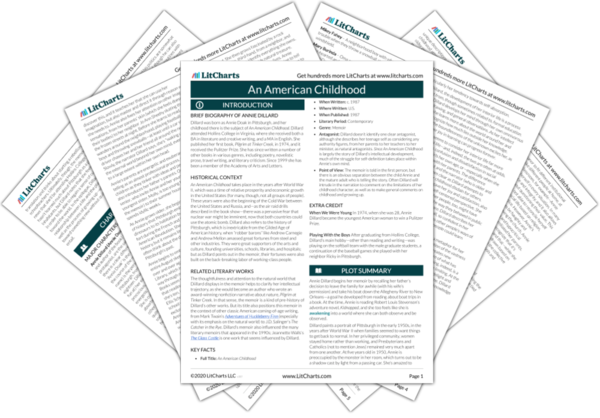Summary
Analysis
Dillard notes that a dream is not much more than its setting: someone is climbing into a ship carrying a baby, or lying on tree branches in an alley, or dancing in a darkened ballroom. The setting of our lives, she says, is a maze: one by one we learn its corridors, without remembering how they connect.
Dillard describes one setting, of a car trip into the mountains in September. The mountain curves away and you walk toward the ridge, she writes: you might then pause to notice that you’re living, and imagine a map and locate this mountain ridge on it, in which a dot would represent you. You might wonder what happened to the other “dots” that made up your life, swimming in the river, swinging a bat, being kissed, stepping into a warm field.
Dillard is talking about herself here, but she switches to the second person in order to make her narration more abstract and general—she’s making a larger point about the ways in which people deal with the relationship between their individual lives, the memories that make them up, and the broader world where they have taken place.
Themes
Dillard moves from the impersonal “you” back to the first person to admit that she does wonder. But she doesn’t want to focus on her personal trajectory. Instead she says that what’s important is for any person to awaken and discover a place, to find the globe already spinning before his or her eyes. She returns to describing the imagined mountain slope, and broaches another problem: “you” might have different, disparate memories, but no proof that all those memories belong to the same person. “You” have to just trust that all these memories are set in the same, wider world. All of your cells have been replaced in the meantime, she says, as well as most of your feelings, except for two: one of lowering your foot into a hot bath, and the other of the subsequent sensation: noticing that you’re here.
Throughout the memoir, Dillard has pointed to places where she felt that her earlier self was too wrapped up in her own personal trajectory. At the same time, however, she’s traced her own awakening, her realization that she inhabits a magnificent world that she should appreciate and learn to wonder at. Living should not just be a process of moving mechanically through each day, she argues: it requires a second step, one of paying attention to all that happens.
Themes
Dillard compares the many different places the reader might be reading this book with the setting where she’s writing it, at a wide desk in a pine shed with young oaks growing outside. Lost in the past, she imagines her own mother, still young and energetic, approaching Annie to bring her back to when she was young. Then she reminds herself that she is here, now, with her own family: she goes back and forth from this awareness many times a day.
Now, many years after the childhood that she has recalled throughout the book, Dillard is equally anchored in a specific place to which she pays close attention. But she is also returning to places and moments of the past, poignantly recalling her mother as a young woman, which she can no longer be.
Themes
Get the entire An American Childhood LitChart as a printable PDF.

Dillard briefly characterizes her childhood: Pittsburgh in the 1950s, in a household of comedians, a childhood filled with books. Perhaps it was because her father left to go down the Ohio River one day that Annie always equated living with leaving, she thinks. She recalls Mother persuading Father to perform or “do” Goofus, an old pantomime routine about a farm boy, grinning stupidly in his character.
Dillard attempts to draw a few specific conclusions from the memories she’s laid out. But as she tries to conclude with a general, logical characterization of her childhood, she finds herself slipping back into specific images and moments from the past.
Themes
Father instructed the children that true American culture was Dixieland, and then jazz. It was a culture of the stock market crash and the Depression and Dust Bowl, all because businessmen realized all at once that paper money was only paper. Of course, Annie thought, as her father explained it to her. She describes other things that “meant” America, from the Golden Gate Bridge to the Chrysler Building, the Chicago World’s Fair to the Erie Canal, and especially the wanderers like Daniel Boone and Johnny Appleseed.
Here Dillard reflects on what she’s meant by titling her book “An American Childhood.” She’s focused on specific details about life in Pittsburgh, but now shows how many of these details are emblematic of American culture, with its combination of hard work, striving for material improvement, and spirit of adventure—both positive and negative qualities, in her account.
Themes
They danced a lot in Annie’s house, and Father always reminded the children of a line in Jack Kerouac’s On the Road, when the narrator was dancing in a Mexican bar and said this was the only time he ever got to hear the music loud enough. Annie was speeding up, getting ready to leave. She drove up and down the highways and over the Pittsburgh bridges. She wrote poems and played piano fast, listened to jazz and wondered if, in New Orleans, the music would be loud enough.
In ending, Dillard returns to the final months before she left Pittsburgh, implying that she wouldn’t return. She suggests that as she prepared to leave home, she was continuing an attitude of curiosity and openness to the world, striving to “hear” the world’s music in a way that would allow her to live to the utmost.
Themes












